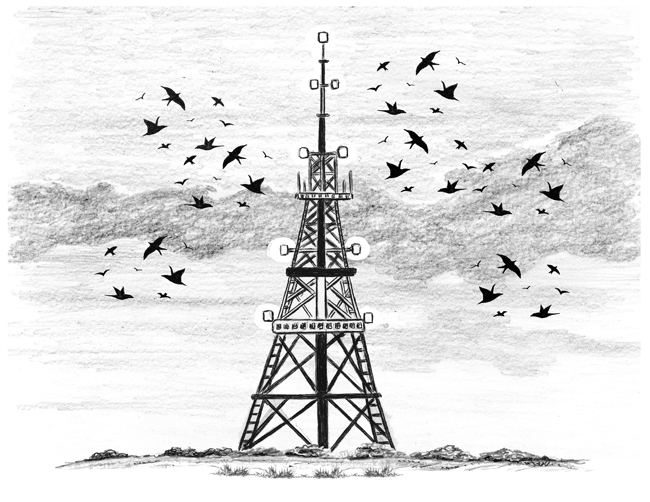
Dear Bird Folks,
A friend of mine read a recent magazine article stating that cell towers cause the deaths of millions of birds each year. Could this possibly be true?
Yes, it is true, Anna,
But do we really have to start off the New Year with such a grim story? Wouldn’t you rather talk about the beautiful cardinals coming to the new feeder you just got from Santa or the flock of bluebirds that are coming to your heated birdbath? Okay, fine. I’ll do it. But if your New Year’s resolution was to stay away from depressing stories, you may want to avoid reading any further. Don’t say I didn’t warn you.
Each year we lose birds to natural causes. These include weather, starvation, diseases and, of course, eating too much bacon. Birds also die from unnatural causes, which are directly related to human activity. This list features oil spills, pesticides and collisions with cars. Cell phone towers are also a problem, but the towers that cause birds the most headaches (literally) are radio and TV towers. Yes, birds are dying so we can watch reruns of Gilligan’s Island. Sure doesn’t seem like a fair tradeoff to me.
How bad are these towers? Very bad. Just ask the next Lapland Longspur you see. Lapland Longspurs are handsome songbirds that breed in Canada and spend the winter here in the U.S. In 1998, over 5,000 of these tiny birds were killed in one night alone by just one communications tower. On another awful night, 7,000 birds were found at the base of a different tower. This time the majority of the victims were warblers and thrushes. Some experts estimate that towers kill five million birds each year, but others argue that the real figure is closer to fifty million. Swell. Don’t get me wrong; the tower companies aren’t trying to hurt birds and likely didn’t even anticipate this problem. After all, birds have excellent vision and can avoid most objects (i.e., they don’t bump into trees). Then why would they hit a skinny tower? It turns out the towers aren’t the real problem. The FAA requires towers above 200 feet to have lights on them and these lights are the troublemakers. Why the lights? Researchers aren’t totally sure, but like moths swarming around a streetlight, migrating birds become confused by tower lights. The problem is especially bad on cloudy or foggy nights. As the lost birds circle around the light, trying to get their bearings, they fail to notice the tower’s guy wires. You can imagine what happens next. Even if the initial collision doesn’t kill the bird, dropping to the ground from several hundred feet will. Once again, swell.
Recent studies suggest that red lights are worse than white lights, and red lights that remain on constantly (instead of blinking) are even worser. So, the answer is simple, right? Just climb up and change the bulbs. Well, it’s not that easy. Some of these towers are 1,000 to 2,000 feet high. I know I’m not going up there. Heck, I don’t even want to hold the ladder. But the real problem is the government. I know blaming the government has suddenly become the easy answer for everything, but it’s actually true this time. The FAA requires the lights, but the FCC makes the rules about communication towers and neither appears to be interested in birds. Meanwhile, the U.S. Fish and Wildlife, whose job it is to protect birds, is getting annoyed by the lack of progress from the other agencies. Welcome to the club.
Fortunately, many nongovernmental environmental groups, including the American Bird Conservancy and the National Audubon Society, are aware of this problem and are pushing for a solution. But as you might imagine, there is no quick fix. At last count there are over 120,000 communication towers and thanks to our love of cell phones, more are going up every day. It should be pointed out that cell towers typically aren’t as tall as TV towers and thus are less of a problem. In other words, watching reruns of Gilligan’s Island is more environmentally damaging than having a cell phone conversation with your mother. (Of course, having a conversation with your mother can be emotionally damaging, but that’s for your therapist to decide.)
Losing five million birds a year to tower collisions is bad, but these towers aren’t the worst things birds have to deal with. The number of birds killed by window strikes each year is in the hundreds of millions and according to some studies, the number of birds killed by free-roaming housecats is in the billions. But unlike the towers, which are out of our control, we can do something to protect birds from glass and domestic predators. Special ultraviolet decals seem to help prevent window collisions and keeping the damn cat in the house will not only save millions of songbirds, it will also protect sweet Mister Pickles from falling victim to coyotes, fishers and the UPS truck.
While it was kind of a drag having to talk about this tower problem, Anna, I’m glad you brought it up. It makes us realize that even minor changes to the landscape can have a profound impact on nature. But don’t get too depressed. There are good things to look forward to. For example: in April, the hummingbirds will return and the orioles will be back in May. And the best item of all, come mid-November those annoying political ads will finally stop. I’m really looking forward to that day.